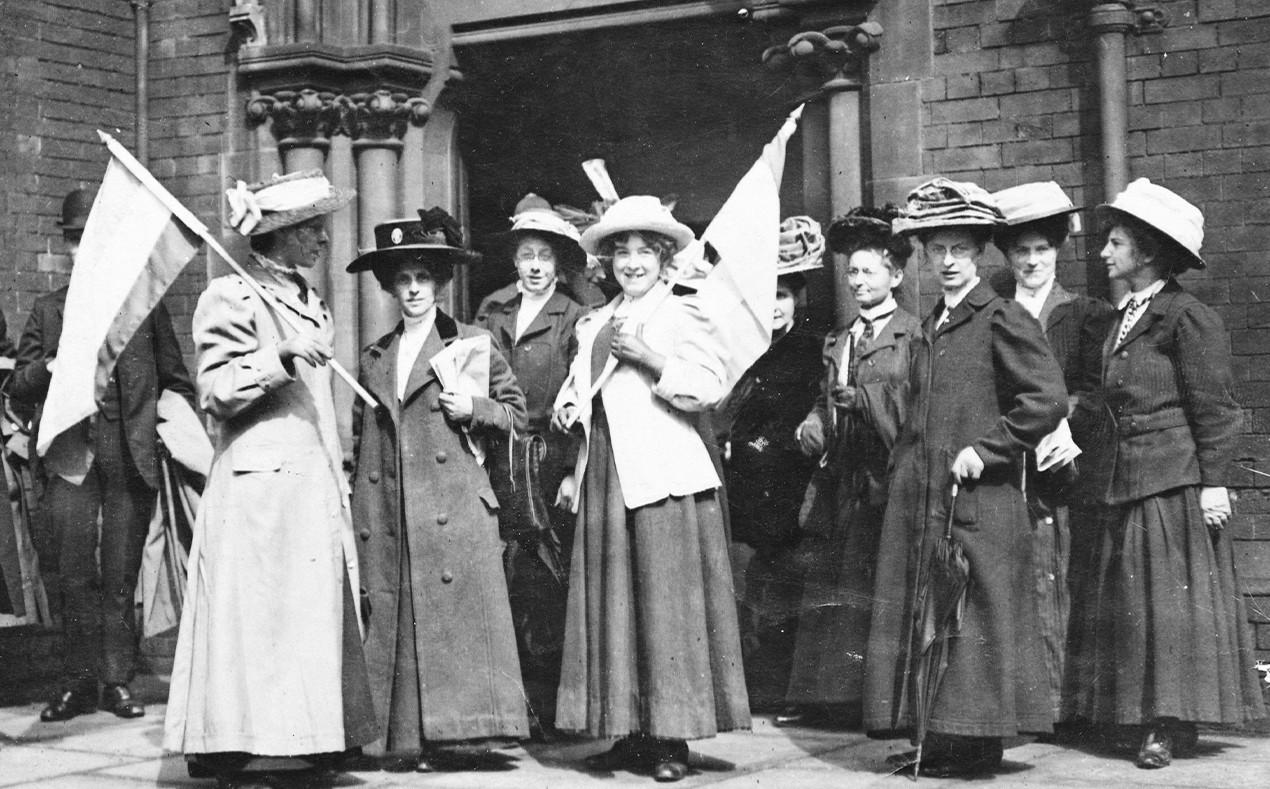Created by Brynne Mills on Wed, 11/17/2021 - 10:48
Description:
The above image shows members of the Glasgow and West of Scotland Suffrage Society’s meeting in Glasgow for a demonstration (“Scottish Women’s Suffrage Movement, 1902-1933”). This demonstration was just one of many suffragist demonstrations in the early twentieth-century and is marked by a struggle for women to regain the opportunities lost to them after World War I (Hughes 1-12). As was the case with women in the United States, Scottish women were not allowed to hold many positions or work many jobs prior to World War I. Women were only expected to operate in the “domestic sphere” of society and to complete tasks such as maintaining the house, caring for the children, cooking, cleaning, and being proper wives (Hughes 1-12). Thus, when World War I approached and demanded the services of Scottish men, the traditional gender roles were challenged by the shift in agency. Women were forced to begin working jobs, particularly jobs that were regarded as being “ ‘safer’ ” (Hughes 13), such as “occupations of retail, transport, commerce, and general employment” (Hughes 13). Opportunities to work in “factories, bakeries, shops, post offices, street cleaning, lamp lighting and policing” also became available (Hughes 13-14), and women were even allowed to operate “horse-drawn vehicles and motors” (Hughes 14). A few women assumed occupations that were previously male-dominated, and many women began working in factories, although the work was specifically made to be “ ‘women’s work’ ” (Hughes 14). Regardless of these new opportunities and the necessity of having women in the workplace at this time in history, though, there was constant assault against women in the workplace during and especially after the war (Hughes 14-21).
During the war, there was concern about women becoming accustomed to regular work, and effort was given to make the workplace less appealing to women. Unions took care to make working conditions for women unsettling and inhumane, emphasizing that women would be “ ‘unfit for motherhood and social life’ ” if women kept working on a regular basis after the war ended (Hughes 14). The most harsh toll on women in this time period, though, was the backlash from the men after World War I ended and the Great Depression began in Scotland. Men returning from war (and those who had stayed home during the war) felt challenged by the presence of women in the workplace and demanded that society return to “normal.” Women were highly discouraged from continuing work at their jobs, and many were forced to return to the domestic spheres of society in the inter-war years (Hughes 14-21). For those who could not afford to resume the previous occupations of being only mothers, wives, and housekeepers, changes were made to employment to discourage women from keeping jobs. Women were often given lower wages than men, “denied benefits,” not eligible for unemployment benefits, not recognized as being employed, given fewer hours to work, etc. to hinder the transition of women into the public sphere of society (Hughes 16, 18). In Glasgow, the city that the women in this image are based in, “the rate of female unemployment was 20 per cent, and this exclud[ed] uninsured workers such as domestic servants” (Hughes 18). Many women were also forced to resign from any jobs upon marrying and were thought of as fragile and incapable of doing “hard” work, especially due to a woman’s emotional instability and possibility of becoming pregnant (Hughes 15, 18-19).
To address the social confusion that accompanied the inter-war period, the insecurity of returning men, and the rising hate towards working women, several femininst groups were formed and/or grown (Hughes 103). The Glasgow and West of Scotland Suffrage Society [GWSS] shown above, an affiliate of the National Union of Societies for Equal Citizenship, was perhaps the most prominent feminist organization in Scotland in the 1900s (Hughes 104-105). This society was mostly comprised of middle-class women and was originally focused on “the representation of women in political life irrespective of party allegiance” (Hughes 105). (One can see the members meeting together for some sort of demonstration or event above.) What the members of this organization refused and failed to do, though, was represent and address labor movements for women. Specifically, most of the members in this society did not represent the needs of working-class women and displayed no desire to help women in the workplace (Hughes 105-108). Another prominent organization at this time, the Independent Labour Party [ILP] (Hughes 34), was often in conflict with the GWSS for these reasons and could not convince members of the GWSS to “support the female candidates put forward by the labour movement” (Hughes 106). Most attribute this failing of the GWSS to the “one-dimensional” feminist concerns that accompanied the first wave of feminism (Hughes 105), regarding the GWSS members as being afraid to completely promote the rights of women in the workplace and unable (or unwilling) to view gender roles through the perspectives of lower-class people (Hughes 105-108).
Works Cited
Hughes, Annmarie. Gender and Political Identities in Scotland 1919-1939. Edinburgh University Press, 2010, pp. 1-37, 103-127. https://purdue.primo.exlibrisgroup.com/permalink/01PURDUE_PUWL/uc5e95/al....
“Scottish Women’s Suffrage Movement, 1902-1933.” British Online Archives, Microform Academic Publishers. https://microform.digital/boa/collections/52/scottish-womens-suffrage-mo...
Additional Resources / Topics of Interest:
Ewan, Elizabeth. “A New Trumpet? The History of Women in Scotland 1300-1700.” History Compass, History Compass 7/2 (2009): 431-446, 10.1111/j.1478-0542.2008.00588.x, vol. 7, no. 2, Blackwell Publishing Ltd, 2009, pp. 431–46, https://doi.org/10.1111/j.1478-0542.2008.00588.x.
Harris, Alana. “Love, Intimacy and Power: Marriage and Patriarchy in Scotland, 1650–1850 KATIE BARCLAY.” Women’s History Review, vol. 22, no. 5, 2013, pp. 851–53, https://doi.org/10.1080/09612025.2012.730743.


